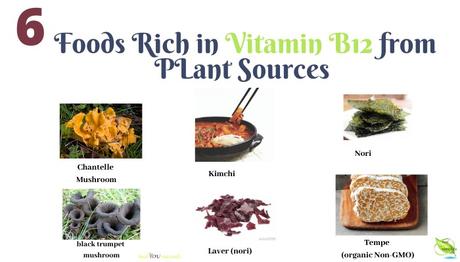
The topic of whether Vitamin B12 rich foods vs supplements can really help those who follow a vegan or vegetarian diet has been long debated. There are supplements that do the job, but as we all know wholesome foods are usually better. That's why I decided to dive deeper into the Cobalamin world.
In this article you will be delight to find what foods really increase Vitamin B12, the way they are cooked or prepared, their origin and how much you need.
I am super excited and you will be too...
Here are six of the Vitamin B12 Benefits and the best Vitamin B12 rich foods for Vegans and vegetarians:
Vitamin B12 Rich Foods (Edible Mushrooms)
Black and Golden Trumpet
Several wild edible mushrooms are popular amongst vegetarians in European and other countries. However, when it comes to dried mushrooms very few traces of B12 were found. In contrast, the fruiting bodies of the black trumpet (Craterellus cornucopioides) and golden chanterelle (Cantharellus cibarius) contained higher levels of Vitamin B12 (1.09-2.65 μg/100 g dry weight) than the abovementioned mushrooms.
Shitake Mushrooms
High levels of Vitamin B12 were detected in the commercially available dried shiitake mushroom fruiting bodies (Lentinula edodes), which are used in various vegetarian dishes. The Vitamin B12 contents of dried shiitake mushroom fruiting bodies (100 g dry weight) significantly varied and the average Vitamin B12 value was approximately 5.61 μg [50]. Dried shiitake mushroom fruiting bodies rarely contained the inactive corrinoid, Vitamin B12[c-lactone] as well as Vitamin B12.
Therefore, consuming approximately 50 grms of dried shiitake mushroom fruiting bodies could meet the RDA for adults (2.4 μg/day). That being said, consuming such large amounts of these mushroom would not be possible on a daily basis. So supplementing with top-notch source such real mushrooms shitake and my favorite is ideal.
Lion's Maine:
Lion's mane mushroom (Hericium erinaceus) fruiting bodies also contain substantial amounts of Vitamin B12. {tabler et al]. demonstrated that Vitamin B12 binds very weakly to the most specific Vitamin B12-binding protein, i.e., the intrinsic factor involved in the gastrointestinal absorption of Vitamin B12, and it strongly inhibits Vitamin B12-dependent enzymes, methylmalonyl-CoA mutase, and methionine synthase. Try Lion's Maine here.
Edible Algae
Nori/Laver (Green and Purple)
Different types of edible algae are consumed around the world as vitamin b12 rich foods sources. The consumption of edible algae around the world is predominantly of green and purple laver.
They contain a great number of vitamin B12 especially when dry. To determine whether dried green and purple laver contain Vitamin B12 or the inactive corrinoid, they were purified in confirmed as vitamin B12.
Researchers found substancial amounts [133.8 mg dry weight] of vitamin B12 in dried Korean purple laver, However, once you cook, season, or toast laver products their vitamin B12 levels drop.
Different types of dried purple and green laver are great sources of Vitamin B12. For example:
(1) a Japanese green laver, (Suji-aonori, Entromopha prolifera);
(2) o rdinary purple lavers (Porphyra sp.; nori, which has been formed into a sheet and dried);
(3) Taiwan purple laver (Hong-mao-tai, Bangia atropurpurea);
(4) New Zealand purple laver (Karengo, a mixture of Porphyra cinnamomea and Porphyra virididentata). [1]
Purple Laver and Vegan Children:
Kimchi
In this study, scientists revealed that Kimchi, a Korean style fermented Chinese cabbage, is a significant source of Vitamin B12. Especially when it is Inoculated with Propionibacterium freudenreichii ss. shermanii. increased vitamin B 12 production to a maximum of 102 ng/100g from 47 ng/100g in the control at 1 wk of fermentation at 4°C.
Propionic acid bacteria (e.g., Propionibacterium shermanii) produce this acid as a product of their anaerobic metabolism of sugars. [2].
Soy flour (0.5%) or beef extract (0.05%), added as protein sources to the inoculated kimchi, further increased the vitamin activity to 197 and 203 ng/100g, respectively, at one week of fermentation. The fresh, unfermented kimchi contained 16.8 mg of ascorbic acid per 100g and the vitamin decreased at a constant rate during the first five weeks of fermentation. [3]
So, it is safe to say that consuming kimchi in combination with the foods mentioned above increases Vitamin B12 Bioavailability exponentially.
Tempe
Several varieties of soybeans generally contain less than 1 ng of vitamin B-12 per grm. In this study, [ 4] scientists found that the use of a lactic fermentation typical of tropical conditions during the initial soaking of the soybeans didn't affect the vitamin B-12 content of the resulting tempeh.
Additionally, It was found that the major source of vitamin B-12 in commercial tempeh purchased in Toronto, Canada, was a bacterium that accompanies the mold during fermentation. Reinoculation of the pure bacterium onto dehulled, hydrated, and sterilized soybeans resulted in the production of 148 ng of vitamin B-12 per g.
Therefore, the presence of the mold, along with the bacterium, didn't inhibit or enhance the production of vitamin B-12. Nutritionally significant amounts of vitamin B-12 were also found in the Indonesian fermented food, ontjom.
It is important to mention that Clostridium freundii and Klebsiella pneumoniae are knowing to produce Vitamin B12, I would prefer to advise that you keep an eye on Clostridium overgrowth, as it can cause adverse health effects. If I was a vegan, I'd opt for other options including fermentation. You can learn more about Clostridium here.
Why add Tempeh to the list? Because in the event other foods aren't available this can be another source that can be consumed sporadically or while watching lab work for pathogens. You can learn more about this in my podcast with Dr. Jessica Peatrose here.
Sources:
1. https://www.ncbi.nlm.nih.gov/pmc/articles/PMC4042564/
2. https://www.sciencedirect.com/topics/biochemistry-genetics-and-molecular-biology/propionibacterium-freudenreichii-shermanii
3. https://onlinelibrary.wiley.com/doi/abs/10.1111/j.1365-2621.1979.tb08525.x
4. https://aem.asm.org/content/34/6/773
Your Turn. Were you aware of these foods are sources of Vitamin B12? Where do you get your Vitamin B12? I'd love to hear your thoughts in the comments below.

